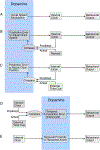Dopamine and the interdependency of time perception and reward
- PMID: 33652021
- PMCID: PMC9062982
- DOI: 10.1016/j.neubiorev.2021.02.030
Dopamine and the interdependency of time perception and reward
Abstract
Time is a fundamental dimension of our perception of the world and is therefore of critical importance to the organization of human behavior. A corpus of work - including recent optogenetic evidence - implicates striatal dopamine as a crucial factor influencing the perception of time. Another stream of literature implicates dopamine in reward and motivation processes. However, these two domains of research have remained largely separated, despite neurobiological overlap and the apothegmatic notion that "time flies when you're having fun". This article constitutes a review of the literature linking time perception and reward, including neurobiological and behavioral studies. Together, these provide compelling support for the idea that time perception and reward processing interact via a common dopaminergic mechanism.
Keywords: Dopamine; Motivation; Reward; Time perception; Timing.
Copyright © 2021. Published by Elsevier Ltd.
Conflict of interest statement
Declaration of Competing Interest
The authors have no competing interests to declare.
Figures




References
-
- Aarts H, Bijleveld E, Custers R, Dogge M, Deelder M, Schutter D, Haren NE, 2012. Positive priming and intentional binding: eye-blink rate predicts reward information effects on the sense of agency. Soc. Neurosci 7, 105–112. - PubMed
-
- Aberman JE, Salamone JD, 1999. Nucleus accumbens dopamine depletions make rats more sensitive to high ratio requirements but do not impair primary food reinforcement. Neuroscience 92, 545–552. - PubMed
-
- Abner RT, Edwards T, Douglas A, Brunner D, 2001. Pharmacology of temporal cognition in two mouse strains. Int. J. Comp. Psychol 14.
-
- Akdoğan B, Balci F, 2017. Are you early or late?: temporal error monitoring. J. Exp. Psychol. Gen 146, 347–361. - PubMed
Publication types
MeSH terms
Substances
Grants and funding
LinkOut - more resources
Full Text Sources
Other Literature Sources

